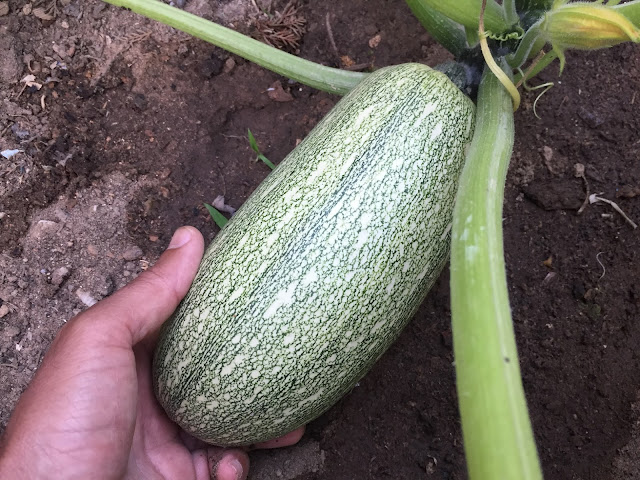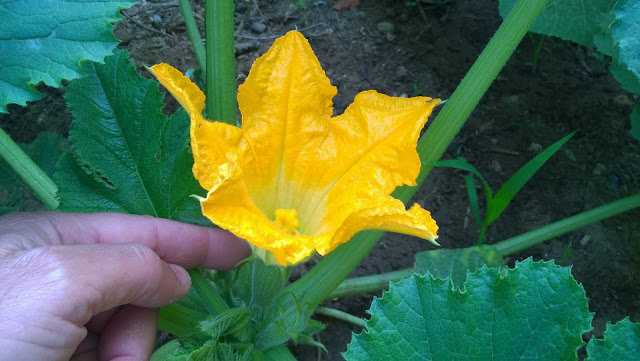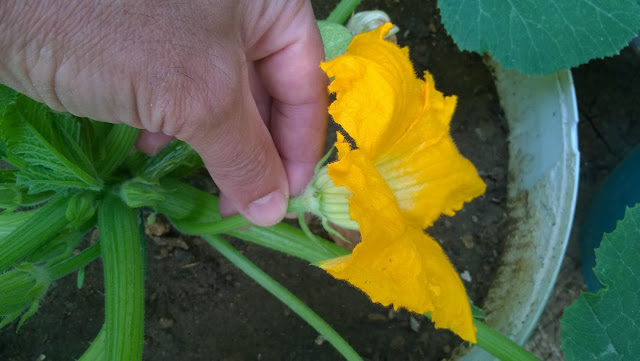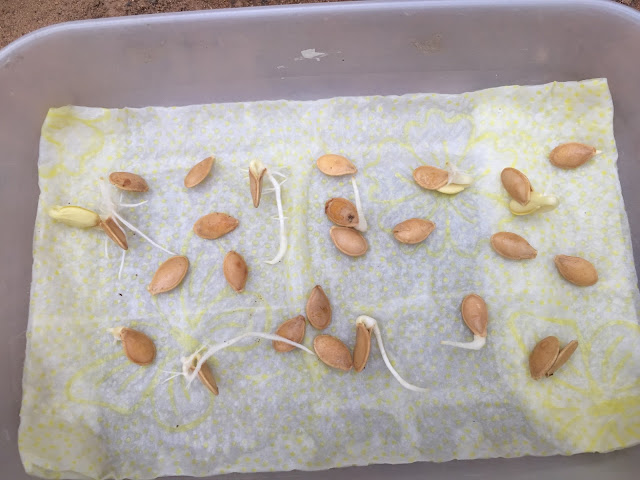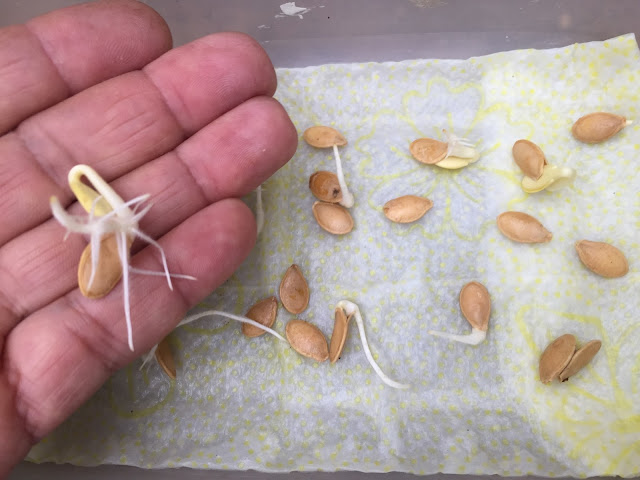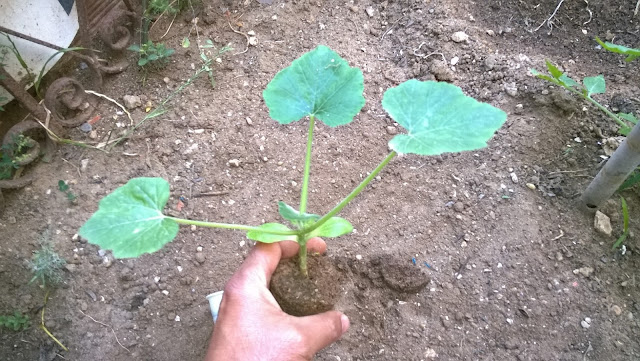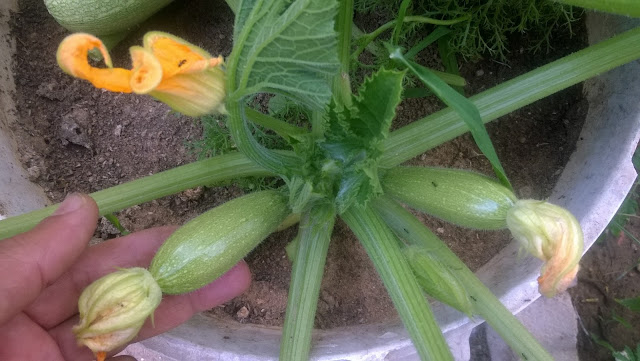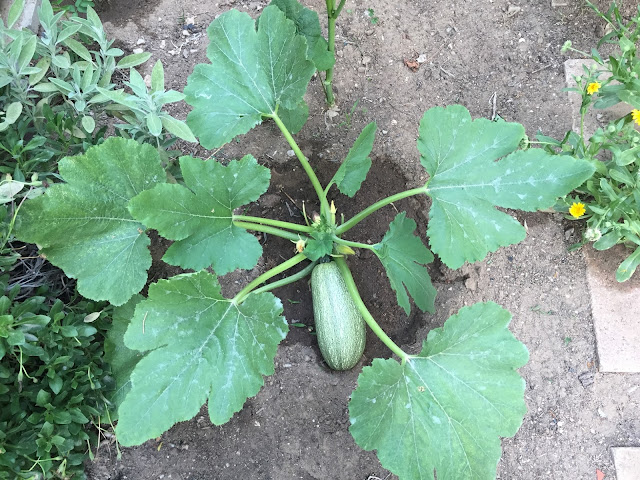
History Of Courgettes
Courgettes Plant Description
Courgettes Flowers
Courgette blossoms are also sometimes called courgette flowers. They are the edible flowers of the courgette plant and usually come in yellow and orange shades. Courgette blossoms are soft, delicate, and taste mildly like the courgette itself they have a subtle flavor, reminiscent of young zucchinis, and can be eaten raw. They are available late spring to early fall. Courgette plants have male and female flowers. There are a lot more male courgette blossoms than female and they begin blooming earlier. The plants produce male and female flowers on the same plant and only the female flowers produce fruit. Insects such bees play a crucial role in the pollination necessary for fruit production they must visit both flowers, taking the pollen from male flowers and transferring it to the female flower. The absence of ideal conditions for pollination and for setting fruits may cause the flowers to fall off before the courgette develops.
Female Flower
Only female courgette blossoms mature into a courgette. The male is just there to fertilize them. The male blossoms outweigh and outnumber the female flowers.
Here’s a picture of a female courgette flower. Notice it has a swollen below the flower that looks like a little courgette. Inside the flower is the stigma, that receives the pollen from the male flower for successful fertilization, usually pollinated by bee or other insect.
Male flower
Male courgette blossoms are edible and delicious. You can easily identify the males from the females:
Male blossoms are attached to a straight stem, whereas female blossoms are attached to a tiny courgette.
Here is a male flower in comparison. Notice there is no little courgette below the flower and it has a single straight stamen pointing out from the center of the flower. The stamen contains all the pollen.
One issue that is of significant concern is poor pollination. Courgette need to be visited by a lot of bees or other pollinators for successful pollination, otherwise the fruits will abort. When this happens the fruits will stop growing, turn yellow and may start to rot. To avoid this make sure you include plenty of pollinator-friendly flowers in and around your vegetable garden, and avoid using any pesticides. Additionally, you can hand-pollinate the flowers - this may be necessary in wet summers when insect pollination is poor.
Watch How to Hand Pollinate Squash Flowers Video
You can use the same technique to hand pollinate your courgette plants!
How to Pick Courgette Flowers
In addition to the edible fruits, you can also harvest the large yellow courgette blossoms and eat them raw or cooked. Only female blossoms produce fruit, so you can harvest most of the male flowers without slowing down the plant's productivity. The plant only requires a few male flowers to pollinate the remaining female blooms so they can set fruit. Examine the base of the flowers in the morning, just after the flower opens, to determine which male flowers are ready for picking. Male blossoms have narrow flower stems and usually open first, while female blossoms open the following day and have a swollen stem that may resemble a miniature version of the mature fruit. You can cut the male flower from the courgette vine with a small pair of shears. Make the cut directly behind the flower head and leave 1 inch of stem attached. Only collect fully open, healthy-looking blooms. Leave some male blossoms on the plant to pollinate the female flowers. Use the blossoms within 24 hours after harvest.
Watch My Organic Courgettes Video
How To Grow Organic Courgettes
Courgettes are one of the most productive crops that vegetable gardeners can grow, one plant can easily produce twenty or more courgettes in just one season. Even with just a few plants you will have courgettes coming out until August! Courgettes are grown for their elongated fruit that are either yellow or green in color. They are a warm season crop intolerant to cold weather.
There are different varieties of courgettes which comes in a variety of size, shape, and color. Choosing varieties that work best for your growing conditions and take advantage of your environment will ultimately decide the outcome of your growing experience.
Starting Courgette Seeds Indoors
This is my technique for starting courgettes indoors, its simple, easy and rewarding!
You can sow Courgettes either inside or outside depending on the weather where you live. I think it's safer to start indoors and plant out later . As courgettes require a long growing season, they are best started indoors approximately 3 weeks prior to the last frost of the season. They are very tender plants and will be badly affected if they get hit by frost, to prevent this start seeds in a greenhouse or windowsill by following my tips you will enjoy growing and harvesting organic courgette in your garden.
Pre sprouting courgette seeds is the easiest way to make sure you plant viable seeds and get a jump on the growing season. It often results in a higher rate of germination since few seeds are lost to environmental factors. By growing courgette indoors, you eliminate the problems of wind damage, insects, other pests such as slugs, and other plant diseases that can thrive in your garden soil.
. Soak your seeds in a glass of water for two days, take off all the water and put gently all your seeds over a paper toilet in a plastic container, cover and put them in a warm place, about five days your seeds will sprout.
. Fill half of the pots with seed compost and plant two or three germinated seeds per pot.
. cover with compost to the bottom and water gently.
. Position the pots in a warm area of the house. Aim for a temperature between 75 and 90 degrees F.
. Water as needed to keep the pots evenly moist.
Watch How to Plant Sprouted Courgette Seeds Video
Once your seeds have germinated then select the stronger one when they have developed a pair of leaves and use a small pair of scissors to snip off the weaker seedling at the base that's the first thing to do. This will give your stronger seedling a better chance for transplanting and disturbing its roots.
 When the roots begin to show at the bottom of the pot your seedlings are ready to transplant into the open ground. Wait until you’re sure there won’t be any frosts, before planting outside. Courgettes are warm weather plants and don’t like chilly nights. If in doubt, keep them in the warm for another week. Plants that have been raised indoors will need to get used to the outdoor temperature and conditions before they can be planted outside. It’s essential to harden off your courgette plants before planting.
When the roots begin to show at the bottom of the pot your seedlings are ready to transplant into the open ground. Wait until you’re sure there won’t be any frosts, before planting outside. Courgettes are warm weather plants and don’t like chilly nights. If in doubt, keep them in the warm for another week. Plants that have been raised indoors will need to get used to the outdoor temperature and conditions before they can be planted outside. It’s essential to harden off your courgette plants before planting.Hardening off means to gradually acclimate the plants to outdoor conditions. When all danger of frost has passed, transplant your seedlings outdoors, and keep them moist and weed-free until well established. If you would rather bypass the need for transplants, sow the seed directly into the ground or containers outdoors in the beginning of June. Even at this late date, the crop should perform admirably .
Planting Courgette Seedlings Outdoor
Courgettes require a well-drained soil and a sunny, sheltered site to thrive. Dig
plenty of well rotted manure in to the soil before transplanting. Prepare well your ground, use well rotted chicken manure to boost the fertility of your soil – if enough is worked into the ground, it should last the whole season.
plenty of well rotted manure in to the soil before transplanting. Prepare well your ground, use well rotted chicken manure to boost the fertility of your soil – if enough is worked into the ground, it should last the whole season.
But if you think the growth is slow use a general purpose organic fertilizer, or make your own chicken manure tea to give a boost to the plant as courgettes are hungry and thirsty plants.
Remember!
Do not to let your seedlings dry out in the few days before planting on, as this would cause them stress and weaken them. You want the soil to be moist, so the roots come out easily, with less damage. Also, avoid transplanting when it’s very sunny and wait till the seedlings are in the shade otherwise they might wilt, before their roots have got over the shock of the move and taken up fresh water.
As the courgette plant grows it will produce a mass of white roots on the surface of the soil. Cover these with potting compost, garden compost or well-rotted manure. Keep covering the roots as they appear and gradually over the course of the summer the moat will disappear and the mound will spread outwards.
Courgette must be kept well watered at every stage of their growth. If the roots are allowed to dry out it will lead to an attack by mildew and the plants will be ruined. Feed the plants once a week with liquid seaweed to encourage plenty of strong healthy growth.
Courgette plants will grow quickly and take up a huge amount of space, much bigger than you think looking at your tidy little plant. The leaves are huge and will shade out anything growing nearby so take this into account when planting them. Planting distance is 1 metre between plants, this will look enormous when you do it but believe me, they'll soon fill the space. Keep the soil around the plants moist, water heavily around the plants in dry weather. Mulch around the plants with straw as it helps moisture retention but also keeps the developing fruits off the ground.
Growing Courgette in containers
Courgette can be grown in containers at least 30cm in diameter. The larger and heavier the container the better to prevent the container from being knocked over by the weight of the tall plant, which can break the stems.
Courgettes can easily be grown in containers but note that Courgettes will grow to be quite large plants, and need a fair amount of spaced between plants about 50/60cms. If Courgettes are grown in pots they will need very regular feeding and watering. Whether growing Courgettes in the ground or pots Courgettes like plenty of organic material and when fruiting the plants will benefit from regular feeding.
In warm weather a good watering will help keep up production. As courgette plant matures the leaves often get white markings on them as in the image left. This is nothing to worry about and the plant is healthy it is part of the courgette leaf's appearance.
Harvesting Courgettes
Courgette problems
Courgette are prone to powdery mildew. Typically, this causes a white dusty coating on the leaves, stems and flowers, especially later in the season as the weather gets warmer and drie.Pests
Slugs and snails are the most serious pests of outdoor plants. Young plants can be badly damaged and need protecting but mature plants will tolerate the damage.
Aphids are occasionally troublesome, primarily on the soft growth at the tips. They can potentially spread virus diseases. Take action early before they become established.
Red spider mite, which causes mottling of the leaves and glasshouse white fly can be a problem not only on crops grown under cover but also on outdoor plants in hot summers, but damaging infestations generally do not build up soon enough to affect cropping.
Enjoy Growing Your Organic Courgette and Happy Gardening!
Organic Courgette Seeds Available HERE!
If you have any tips for growing organic courgette, we'd love to hear them - please share them in the comments below.




